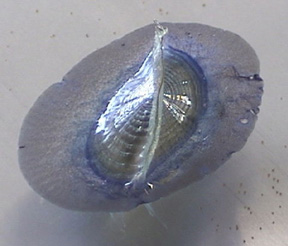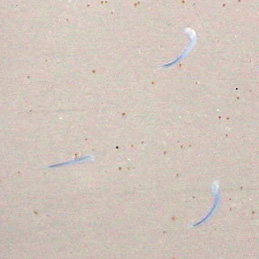
By Curt
Beebe
Mike
Baird and I collected some fresh Velella velella as they blew up on the
beach. I floated these in a pan, and took photo Number 1. Notice the tentacles
hanging down at the bottom of the picture. 
The jellies’ mantle is water repellent
on its upper surface. This causes the organism to right itself if tipped over by
a wave.
Jellies are very fragile. As autolysis
began the tentacles were shed first. They can be seen lying on the bottom of the
pan in picture Number 2. 
My understanding is that Velella medusae are communal hydroids, and each tentacle is an individual. The clear base of the tentacle contains a branch of the communal stomach, which is how each individual gets its share of the catch.
When autolysis was complete only the chitinous sail mechanism remained.
|
|
|
base of the sail mechanism, that attached to the jelly. I am gripping the “sail.” |
particularly well. |
|
|
|
from its side. |
shown further in Number 6. |
When the wind blows on the sail,
Velella first turn sideways, and begins to drift downwind. The twist of the base makes drag greater on the left; that twists the organism counterclockwise, and the
Velella begins to sail!
Velella live in the open ocean. Off our coast Velella sail 45 degrees to the left of downwind, at mild and moderate wind velocities. (1) During the winter southwesterly blows this helps keeps them off our shore. However, with the advent of prevailing northwesterlies in spring, large numbers can be blown ashore. The same phenomena occur in Australia, in the winter and spring of the southern hemisphere.
Biologically, it is a simple trick to reverse symmetry. Velella off the coasts of Japan and Chile tack in the opposite direction! The winds blow in opposite directions from here, and the twist of the base is opposite. (One of you world travelers PLEASE bring me a picture.)
[Editor's
note: here is
an example from the UK, where the twist appears to be opposite] ![]()
Massive beachings of Velella are not common. The last one in this area was in ’89 or ’90. (2)
References:
1. Lane Community College web site (Oregon) http://lanecc.edu/science/zonation/sailor.htm
2. Central Coast Audubon hotline
Addendum by Mike Baird
Here are some additional related Internet references:
PBS - The Voyage of the Odyssey - Voice from the Sea http://www.pbs.org/odyssey/voice/20020407_vfts_transcript.html (this is a pretty good article)
By-the-Wind Sailor Velella velella http://www.earthwindow.com/velella.html (this contains a neat 360 degree image)
Jack-Sail-By-The-Wind (Velella velella) http://www.imagequest3d.com/catalogue/surfacedrifters/pages/j060_jpg.htm
Okinawa Slug Site http://rfbolland.com/okislugs/velella.html

Monterey Bay National Marine Sanctuary "special Velella link" at http://bonita.mbnms.nos.noaa.gov/ (link may have expired)
Waste Magazine (in Spanish) article http://www.ideal.es/waste/especies32.html
Eathhguide http://earthguide.ucsd.edu/earthguide/imagelibrary/velellavelella.html
Fisheries Centre, The University of British Columbia http://www.fisheries.ubc.ca/projects/pwsound/AlaskaEco/GYRE/GYRREP9.HTM
Dock Watch Identification Chart for Jellies http://dockwatch.disl.org/glossary.htm
British Marine Life Study Society Jellyfish Page http://ourworld.compuserve.com/homepages/BMLSS/Moonjell.htm
eNature article (click here) (more info)
Hydrozoa by Peter Schuchert http://www.geocities.com/peterschuchert/Hydrozoa.htm
Australian "southernshores" http://www.southernshores.auz.info/beachcombing/archives/dec.htm